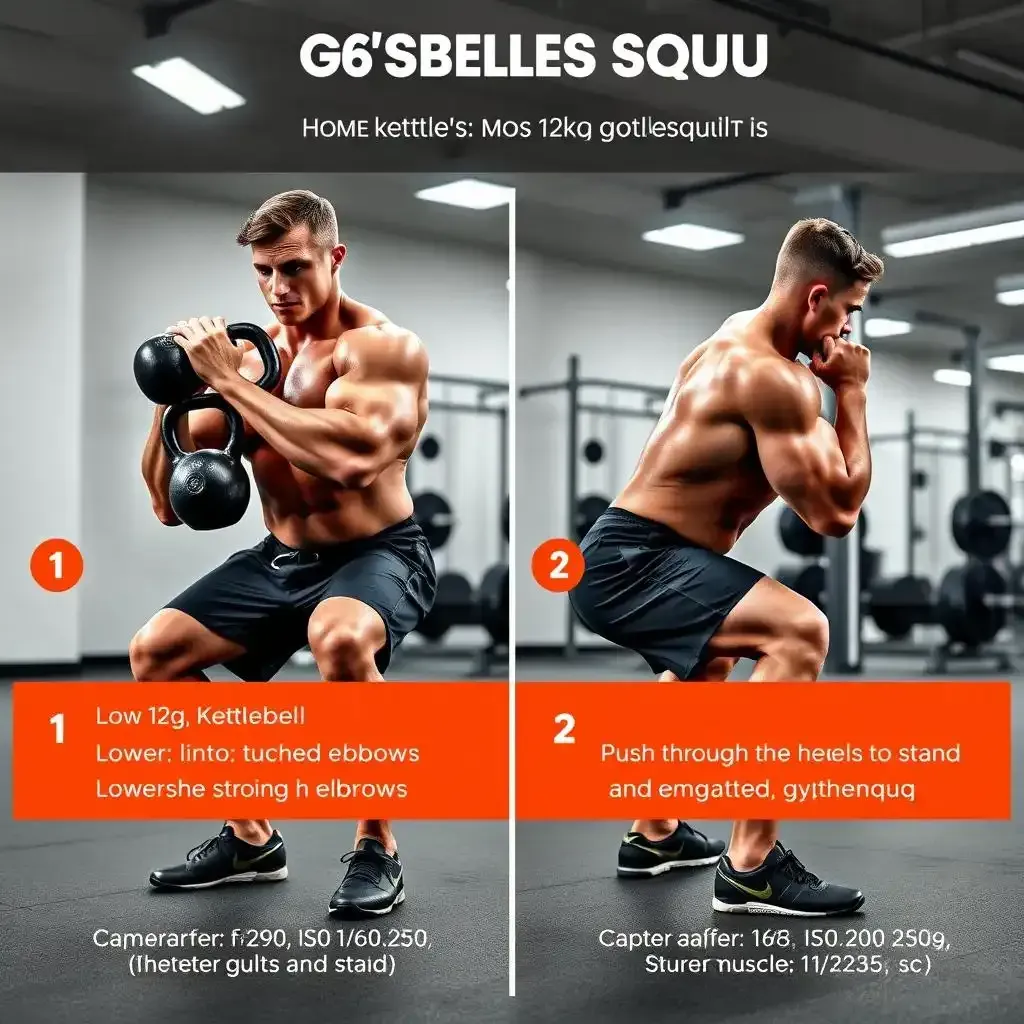Table of Contents
Hey there, fitness fanatics! Ready to let loose your inner powerhouse? Forget complicated gym routines; today, we’re focusing on the strength of simplicity. At kettlebellworkout.homes, we believe in efficient, effective workouts. That’s why we're diving into two incredibly versatile 2 kettlebell exercises that will transform your fitness progression. These aren't just any exercises; they're foundational movements that build strength, endurance, and coordination. We’ll show you how to perform the kettlebell swing and the goblet squat correctly, emphasizing proper form to prevent injuries and maximize results. Get ready to sculpt your physique and boost your overall fitness with these two dynamic 2 kettlebell exercises. Let's get started!
Two Kettlebell Exercises: Mastering the Kettlebell Swing
Getting Started: Finding Your Swing
Hey there, future kettlebell kings and queens! Let's talk about the kettlebell swing, a move so awesome, it's practically a party in your muscles. Think of it like this: you're a powerful pendulum, smoothly transferring energy from your legs to your arms. It's not about brute strength; it's about controlled capability. Imagine swinging a mighty hammer, not just flailing it wildly. That's the key! Start with a lighter kettlebell—don't be a hero on day one! You want to feel the movement, not be battling the weight. Once you've got the hang of it, you can slowly work your way up. I started with a 10kg kettlebell, and trust me, that was enough for my first few weeks. It's like learning to ride a bike; you gotta start small and work your way to the big leagues.
Step | Action | Tip |
|---|---|---|
1 | Stand with feet shoulder-width apart, kettlebell between your legs | Keep your back straight, like a proud giraffe! |
2 | Hinge at your hips, keeping your back straight | Imagine you're trying to push your hips back into a wall. |
3 | Swing the kettlebell up to chest height using your legs and hips | Don't use your arms; they just go along for the ride. |
4 | Control the kettlebell's descent back between your legs | Think of it as a smooth, controlled pendulum motion. |
Perfecting Your Form: Swinging Like a Pro
Okay, so you've done a few swings. Now, let's get serious about perfecting your form. Think of your body as a finely tuned machine—all parts working together in perfect harmony. A wobbly swing is like a car with a flat tire; it's not gonna get you where you need to go efficiently. The most common mistake I see is people using their arms to lift the kettlebell. Remember, the ability comes from your legs and hips—your arms are simply along for the ride. Imagine yourself throwing a medicine ball, but in a controlled, repetitive manner. It's all about that hip-hinge strength! Another common issue? Rounding your back. That's a big no-no! It can lead to injury. Keep that back straight, like a proud soldier at attention. And remember, breathe! Proper breathing is essential for any exercise. Inhale as you hinge, exhale as you swing.
- Engage your core muscles throughout the movement.
- Keep your shoulders relaxed and down.
- Maintain a neutral spine (no arching or rounding).
- Focus on a smooth, controlled swing.
- Listen to your body. If it hurts, stop!
Taking it Further: Variations and Progressions
Once you've mastered the basic kettlebell swing, the world is your oyster! There are tons of variations and progressions you can try. Think of it like leveling up in a video game—each new challenge makes you stronger. You can try different grips or increase the weight. You can also incorporate other movements, like squats or lunges, to create a full-body workout. Don't be afraid to experiment and find what works best for you. For example, I like to incorporate the swing into my HIIT (High-Intensity Interval Training) sessions. It's a killer cardio workout that also builds strength. But remember, always prioritize proper form over speed or weight. It's better to do fewer reps with perfect form than many reps with sloppy form. Safety first, always!
"The kettlebell swing is a fundamental movement that can be used to build strength, capability, and endurance. It is a versatile exercise that can be adapted to different fitness levels." - *Some random kettlebell expert*
Two Kettlebell Exercises: Building Strength with the Goblet Squat

Two Kettlebell Exercises Building Strength With The Goblet Squat
Getting Comfortable: Your First Goblet Squat
So, you're ready to try the goblet squat? Awesome! This exercise is like a superhero ability-up for your legs and glutes. Imagine you're holding a big, heavy pumpkin – that's your kettlebell. You’re going to squat down like you're about to sit in a comfy chair, but instead of a chair, you've got the floor. It's all about that controlled descent and powerful ascent. Don’t start with a weight that’s going to crush you; choose a kettlebell that feels manageable. Remember when I first tried it? I started with a 12kg kettlebell, and it was perfect for finding my balance and understanding the movement. Start slowly, focus on your form, and then increase the weight as you feel stronger. It's a trip, not a race!
Step | Action | Tip |
|---|---|---|
1 | Hold the kettlebell close to your chest, like a big hug. | Keep your elbows tucked in. |
2 | Slowly lower yourself down, like you're sitting in a chair. | Keep your back straight, like a proud tree trunk. |
3 | Push through your heels to stand back up. | Engage your glutes and quads! |
4 | Repeat! | Aim for 10-12 reps to start. |
Mastering the Move: Perfecting Your Goblet Squat
Okay, you’ve done a few goblet squats. Now let's fine-tune your technique. The most common mistake? People tend to lean forward too much. Imagine a string pulling you up from the crown of your head; that’ll help keep your back straight. Another common slip-up is not going low enough. You wanna feel that stretch in your thighs and glutes. That's where the magic happens! Think of your body as a well-oiled machine, every part working together in perfect harmony. If you feel any pain, especially in your knees, stop immediately. Listen to your body, it's always right. And remember to breathe! Inhale as you lower yourself, exhale as you stand up. It’s not just about the physical exercise; it’s about the mindfulness too!
- Keep your weight in your heels.
- Keep your chest up and your shoulders back.
- Don't let your knees cave in.
- Maintain a controlled pace.
- Focus on proper form over speed or reps.
Leveling Up: Goblet Squat Variations and Challenges
Once you’ve got the basic goblet squat down pat, it’s time to spice things up! There are tons of ways to make this exercise more challenging. You can increase the weight of the kettlebell, of course. You can also try adding pauses at the bottom of the squat to really work those muscles. Or, try incorporating a jump at the top of the squat for an extra cardio boost. I like to do a set of regular goblet squats, followed by a set of jump squats. It’s a killer workout! Remember, always focus on maintaining good form, no matter how challenging you make it. It’s better to do fewer reps with perfect form than a ton of reps with poor form. Safety first, always! Keep experimenting and finding what works best for your body. And remember, have fun!
"The goblet squat is a fantastic exercise for building lower body strength and improving overall fitness. It's a simple yet effective movement that can be incorporated into any workout routine." - *Your Friendly Neighborhood Fitness Guru*
Two Kettlebell Exercises: Workout Routines and Safety Tips

Two Kettlebell Exercises Workout Routines And Safety Tips
Crafting Your Kettlebell Workout: A Personalized Approach
Okay, so you've mastered the swing and the squat – high five! Now, let's talk about putting them together into a killer workout. Don't just randomly throw exercises together; think of it like building with LEGOs – you need a plan! A good workout should target different muscle groups, incorporate various intensities, and, most importantly, be fun! I personally love doing a circuit-style workout. For example, I'll do 10 kettlebell swings, followed by 10 goblet squats, then a 30-second rest. I repeat this circuit three times. But that's just me. You need to find what works best for *your* body and preferences. Experiment with different rep ranges, rest times, and exercise combinations to find what flows best for you. Think of it as a recipe – you can always tweak the ingredients to make it your own masterpiece!
Workout Day | Exercise | Sets | Reps | Rest |
|---|---|---|---|---|
Monday | Kettlebell Swings | 3 | 10-12 | 60 seconds |
Monday | Goblet Squats | 3 | 10-12 | 60 seconds |
Wednesday | Kettlebell Swings | 3 | 15-20 | 90 seconds |
Wednesday | Goblet Squats | 3 | 15-20 | 90 seconds |
Friday | Kettlebell Swings | 3 | 12-15 | 60 seconds |
Friday | Goblet Squats | 3 | 12-15 | 60 seconds |
Listen to Your Body: The Importance of Rest and Recovery
This is crucial, people! You wouldn’t run a marathon without training, right? The same applies to your kettlebell workouts. Your body needs time to recover and rebuild. Don't push yourself too hard, too fast. Start slowly and gradually increase the intensity and duration of your workouts. Remember, consistency is key, not intensity. I used to make the mistake of thinking more was always better. I ended up injured and burnt out. Now, I prioritize rest and recovery. I usually take at least one day off between workouts, and I listen to my body. If something hurts, I stop. It's not about pushing through the pain; it's about working smarter, not harder. Think of your body as a finely tuned engine – you need to give it the right fuel and regular maintenance to keep it running smoothly. Prioritize sleep, nutrition, and hydration.
- Rest at least one day per week.
- Listen to your body and don't push through pain.
- Stay hydrated by drinking plenty of water.
- Eat a balanced diet to fuel your workouts.
- Get enough sleep to allow your body to recover.
Safety First: Avoiding Kettlebell Injuries
Let's be honest, kettlebells are awesome, but they can also be dangerous if you're not careful. Think of them as powerful tools – respect them! The most important thing is to focus on your form. Poor form is the number one cause of kettlebell injuries. If you’re unsure about your form, it’s always a good idea to consult a fitness professional or watch videos demonstrating proper technique. Start with lighter weights and gradually increase the weight as you get stronger. Don't be a hero and try to lift more than you can handle. Remember that time I tried to impress my friend with a ridiculously heavy kettlebell? Yeah, let's just say I learned my lesson. It’s better to be safe than sorry! Always warm up before your workout and cool down afterward. This helps prevent injuries and improves your overall performance.
"The key to successful kettlebell training is proper form and gradual progression. Don't rush the process, and always prioritize safety." - *A wise kettlebell instructor*
Final Thought
So there you have it – two incredibly effective 2 kettlebell exercises to add to your arsenal. Remember, consistency is key. Start slowly, focus on proper form, and gradually increase the weight and repetitions as you get stronger. Listen to your body, and don't hesitate to modify the exercises as needed. With dedication and the right technique, you'll be amazed at the results you achieve. Happy lifting!